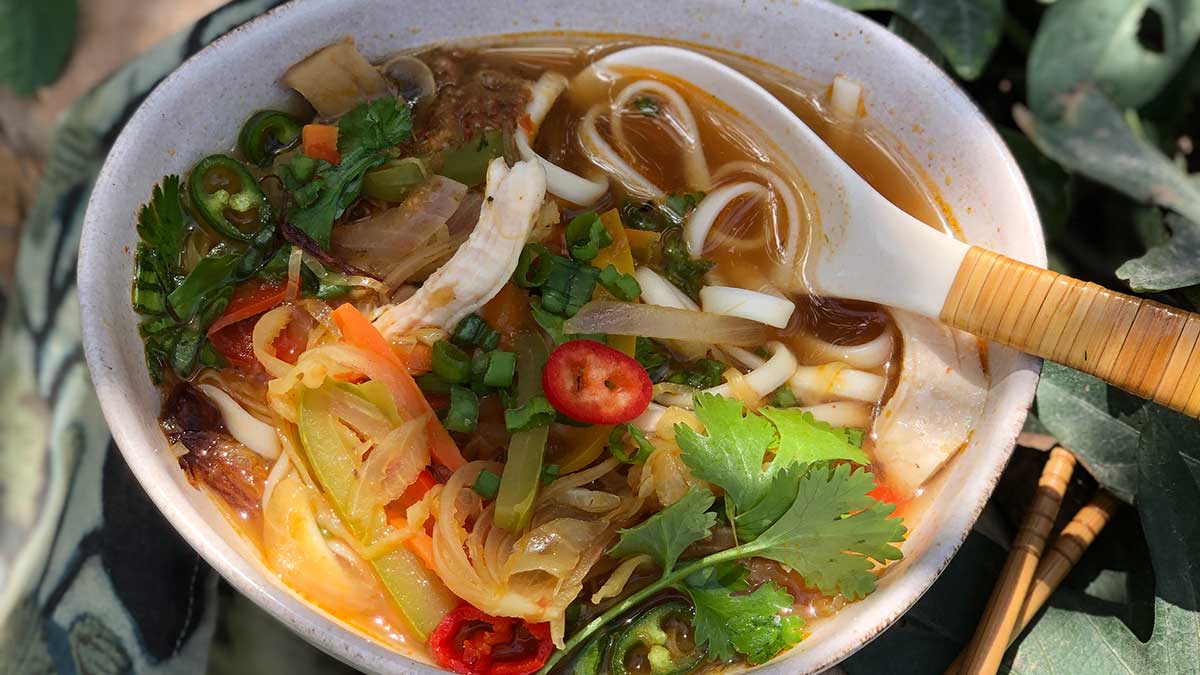Ramadan Recipes
Ramadan Recipe: Thukpa

Global March 31, 2022 - By
A healthy recipe consisting of protein, whole grains and legumes, and fibrous vegetables and fruits.
With the Holy Month of Ramadan starting, Muslims around the world will fast from dawn to dusk every day by abstaining from eating and drinking. Because there are only two meals during the day, it’s even more important to eat a healthy meal consisting of protein, whole grains and legumes, and fibrous vegetables, and fruits.
The emphasis on clean eating has picked up momentum, and this recipe promises just that! Whether you're a beginner in the kitchen, love cooking, or find yourself crunched for time, this dish will feature repeatedly in your menu planning!
Memories of Thukpa were re-awakened during my holiday last month to a beautiful destination in the foothills of the Himalayas. The first time we had Thukpa — a bowl full of everything delicious — was during our trek in Nepal some 20 years ago or so.
I remember long and cold days in the Annapurna region, trekking along an uphill, rocky terrain and ending the day with a flavorsome and zesty bowl of broth, with noodles, chicken and vegetables to beat the chills- it felt like a big warm hug! Some days, I preferred vegetarian thukpa, and it was always tasty.
Originating from Tibet, this dish is popular in Nepal, the Himalayan regions in India near Tibet and in the Northeastern states of India. It can be described simply as a soupy noodle dish where noodles meet a broth spiced with ginger, garlic, onions, and other veggies.
Topped with cilantro, green onions and freshly squeezed lemon juice it’s comforting, delicious and healthy! Simple flavors work their magic in this one-pot/wok dish and it’ll look like you’ve slaved all day when you serve it.
So go give it a try!
Ingredients (for 2-3 persons)
150 grams dry noodles (use egg noodles, buckwheat, rice noodles or spaghettini)
150 grams of shredded chicken (omit if vegetarian)
4 cups of chicken broth (for use vegetable broth)
2 tablespoons oil
1/2 onion
1 inch piece of ginger
4 cloves of garlic
1 green chili
1 cup cabbage
1 cup red, green and yellow bell pepper
2 mushrooms (brown or white)
1/4 cup carrots
1 medium tomato (70-80 grams)
Pinch of black pepper powder
Pinch of crushed Sichuan pepper
½ teaspoon cumin seed powder
1 teaspoon or more salt to taste
1-2 teaspoon light soya sauce
¼ teaspoon turmeric powder (optional)
½ teaspoon red chili powder (optional)
Garnishes
Wedges of lemon or lime, light soya sauce, cilantro leaves, chopped red and green chilies (optional), fried onions (optional), spicy hot sauce or chutney (optional), finely chopped green onions.
Directions
1. Start with making the noodles as per instructions on the package to an al-dente. Since they will be soaked in the broth after, avoid making them too soft. After draining out the water and rinsing with cold water to stop further cooking, save in a covered bowl. Add a half teaspoon of oil to prevent them from sticking together.
2. Prep all your vegetables for the dish. Finely chop ginger, garlic and green chili. Thinly slice onion and mushrooms; julienne carrots, cabbage, and bell peppers; puree the tomato.
The video is blocked
3. In a medium wok, add two tablespoons of oil such as sesame oil or a vegetable oil. At smoking point add the chopped ginger and garlic and bring the temperature down to a medium. Stir fry to a very light pink.
4.Add sliced onions and chopped green chilies. Fry for a minute on medium and add the tomato puree.
5. Fry for a minute and add the spices- salt, black pepper and Sichuan pepper powder, turmeric, cumin seed powder and red chili powders are optional.
The video is blocked
6. Without letting the spices burn, add the 4 cups of chicken broth and a teaspoon of salt. Bring the heat to medium high till the broth reaches a simmer.
The video is blocked
7. Next, add the veggies— mushrooms, cabbage, red and green pepper. Cook on a low simmer for two minutes. The vegetables need to retain a bit of crunch so be sure when you bring the broth with the veggies back to a simmer that you don’t overcook.
8. To finish, add the soya sauce, lemon or lime juice and taste test for salt again.
The video is blocked
9. To serve, take a deep bowl, add the noodles, shredded chicken and using a ladle, add the soup and veggies to the bowl. Garnish with sliced green onions, cilantro and a wedge of lemon or lime. A tomato garlic chutney or a hot sauce is preferable if you enjoy some heat.
Enjoy Thukpa!
Tips to take it up a notch
1, An optional condiment for Thukpa is a hot chutney. Make it coarse in texture using a blender. Add 2 grilled and charred tomatoes-peeled and quartered, 2 peeled cloves of garlic, 2 tablespoons of chopped green onions, handful of cilantro leaves, salt, black pepper, sichuan pepper, rehydrated dried red chillies with a touch of lemon juice. Use spices to suit your taste.
2. Serve the broth and veggies in a deep pot and garnishings in bowls to add extra some oomph to the meal.
3. Use different vegetables like baby spinach, bok choy, baby corn and broccoli in the broth. Use different garnishes like strips of a plain omelet, halved boiled eggs and fried garlic.
4. Create “Mokthuk”- momos or dumplings dunked in Thukpa. You can make the dumplings or buy store bought momos or gyoza or dumplings and most importantly, the stock and dumplings can both be vegetarian.
Follow Sapna Kokal's blog @myrootsmystory on instagram, and go to https://myrootsmystory.com for more recipes and ideas.



